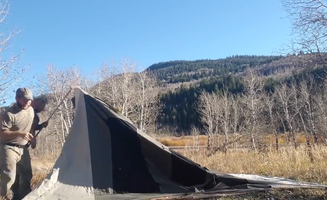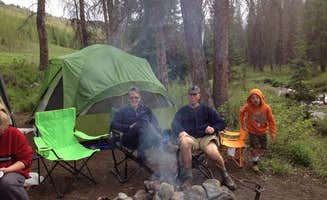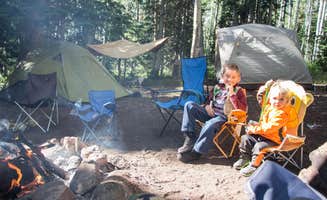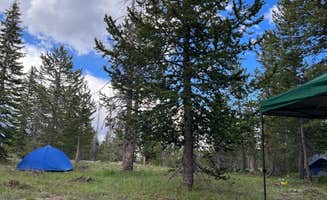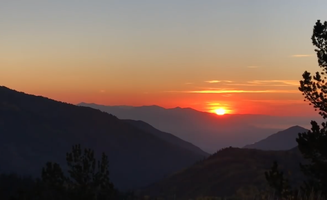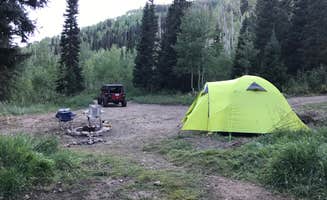Dispersed camping near Kamas, Utah ranges in elevation from 7,500 to 10,000 feet, creating significant temperature drops compared to nearby urban areas. Summer nights often dip below 45°F even when daytime temperatures reach the 70s. Most dispersed camping occurs in mixed conifer and aspen forest environments with meadows that bloom from mid-June through August.
What to do
Fishing opportunities: Several lakes and streams in the Uinta-Wasatch-Cache National Forest offer trout fishing within a short drive or hike from camping areas. At Pyramid Lake, "Fly fishing is great here, just remember your fishing license," notes Ethan H. The lake remains relatively uncrowded, with one visitor reporting that "the trout were very active midday into the late afternoon."
Hiking nearby trails: Access multiple trail networks directly from dispersed camping areas. Near Mineral Basin Dispersed, "Pittsburgh Lakes trailhead was just a little farther up the road from us," according to one camper. The basin offers "lots of great hiking" with trails accessible directly from camp.
Wildlife observation: Early mornings provide opportunities to spot various animals in meadows and near water sources. One Mill Hollow camper mentioned, "I've seen plenty of chipmunks and even had two elk run past my campsite," while others report moose sightings at dawn and dusk.
What campers like
Temperature relief: The higher elevation provides significant cooling during summer months. At Wolf Creek Pass Primitive Areas, "Temps are significantly cooler," writes Taylor S. The elevation difference creates natural air conditioning during hot months.
Star visibility: Minimal light pollution allows for exceptional night sky viewing. A Soapstone Basin camper noted their appreciation for "the dark moonless night," while others mentioned star visibility as a primary attraction for camping in these remote locations.
Isolation options: Campers can find secluded spots by driving farther on forest roads. Connor O. describes Mineral Basin Dispersed as "secluded camping yet still close" to amenities. At Wolf Creek Pass, another camper mentioned, "The spots are very secluded. Didn't even know people were camping near us until we went for a walk."
What you should know
Vehicle requirements: Many roads deteriorate significantly beyond main access points. For Cascade Springs Dispersed, Carson S. warns, "You will need 4WD and high clearance to pass through the washouts and rocks which start near the entrance and go all the way to the top."
Seasonal bugs: Biting insects can be problematic in early summer. One Wolf Creek Pass visitor bluntly stated, "Every site in every area from here to mill hollow is packed with swarms of biting flies. Seriously. Don't come here."
Water sources: No reliable drinking water exists at dispersed sites. A Mill Hollow camper advised, "This is LNT (leave no trace) camping so be sure to pack out what you pack in. There are no amenities but you are along a water source so if you have a filter, you have water."
Tips for camping with families
Best locations for children: Some areas offer safer environments for younger campers. The Uinta-Wasatch-Cache National Forest Dispersed Camping areas feature "open fields and meadows you'll find that provide amazing views" according to one reviewer, making them suitable for families needing space for children to explore safely.
Wildlife awareness: Bears and other large mammals frequent these areas. One Willow Spring camper reported, "A bear crawled onto the roof of my Jeep while I was in it sleeping. Heads up when camping here." Teaching children proper food storage and wildlife awareness is essential.
Weather preparedness: Mountain storms develop rapidly, especially in summer afternoons. A visitor to Pyramid Lake recommended, "We were able to drive right to the waters edge to camp and there were plenty of open beaches to choose from! The water was clean and refreshing." However, they cautioned about changing weather conditions requiring appropriate gear.
Tips from RVers
Road conditions for trailers: Most dispersed areas require careful navigation with towed units. Jake T. reported about Soapstone Basin: "I would say 4x4 isn't needed but a higher clearance SUV or truck would be a good idea." Another camper noted, "The road at times was a bit rough for my little Ford escape and tab camper."
Site selection strategies: Arrive early to secure spots suitable for larger vehicles. At Willow Spring, one reviewer observed, "You can find a spot anywhere if you are pulling in your van/car/truck but if you have a rig you want to get in here early as it gets full with RVs."
Preparation needs: No services means complete self-sufficiency is required. As one camper at Uinta-Wasatch-Cache National Forest noted, "Didn't go all the way up as we arrived late but we encountered no snow. The road is a bit rough, mainly due to water runoff but nothing too bad."


